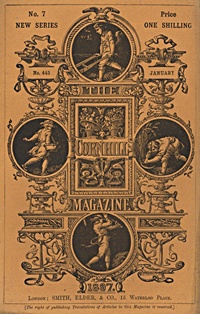 The Cornhill Magazine (London, UK)
The Cornhill Magazine (London, UK)
- The Lagoon (Jan 1897)

January 1897
Founded in 1860 by the publisher George Murray Smith, The Cornhill Magazine quickly established itself as one of Britain's most prestigious literary monthlies. During its first two decades, the magazine attracted contributions from the likes of Anthony Trollope, Elizabeth Gaskell, Robert Browning, Alfred Tennyson, George Eliot, Thomas Hardy, and Wilkie Collins. It serialized Henry James's Washington Square in 1880, Arthur Conan Doyle's The White Company in 1891, and two late pieces by Stephen Crane, 'A Self-Made Man' and 'God Rest Ye Merry Gentlemen', in 1899. Reduced to sixpence in 1883, its price returned to one shilling in June 1896. While the arrival of the new magazines modelled on The Strand displaced The Cornhill Magazine as the preeminent publisher of new fiction, it continued to attract submissions from major writers until its closure in 1974. Editors included: William Makepeace Thackeray (1860-1862); George Smith, Frederick Greenwood, G.H. Lewes, and Edward Cook (1862-1871); Leslie Stephen (1871-1882); James Payn (1883-June 1896); John St Loe Strachey (July 1896-Dec 1897); and Reginald Smith (1898-1916).
By 1896, Conrad had won plaudits for Almayer's Folly (1895) and An Outcast of the Islands (1896) yet found himself in financial straits following the loss of his inheritance in a South African mining venture the previous year. At this critical juncture, as he abandoned The Rescue in favour of The Nigger of the 'Narcissus', Conrad turned to serialization as a means of boosting his income from writing. Following an introduction to E.V. Lucas in June 1896, Conrad was approached by Charles Larcom Graves, Lucas's collaborator and an assistant editor at The Cornhill, about submitting his work: '[To] judge from the remarkable brilliancy and power of your published work . . . it is very unlikely [the Editor] should decline anything you sent him' (PL 24). Conrad's opinion that 'this Cornhill is not a bad mag. to appear in' (CL 1:286) was shared by his friend Edward Garnett, who pointed out that it paid 'fairly well' (a guinea per page) and that the publishers Smith, Elder, & Co. would make 'a determined effort . . . to push the Magazine now that the old editor James Payn has resigned' (PL 23). Conrad responded by submitting 'The Lagoon', declaring confidently to Garnett: 'It's a tricky thing with the usual forests rivers--stars--wind sunrise, and so on--and lots of secondhand Conradese in it. I would bet a penny [The Cornhill] will take it' (CL 1:301).
Despite discussions with Reginald Smith in November 1896 about the possibility of serializing The Rescue or The Nigger of the 'Narcissus', Conrad published only one story in The Cornhill. Even so, the magazine was instrumental in introducing him to the world of literary periodicals. The following year, he told his publisher T. Fisher Unwin that he was at work on 'something in the style of that short tale I wrote for the Cornhill', adding: 'I rather think the Cornhill might take it as I had some kind of intimation to the effect that they would take my stories there' (CL 1:338). Had 'Karain' not been accepted by Blackwood's Magazine, thereby marking the start of Conrad's involvement with the house of Blackwood, The Cornhill and Smith, Elder, & Co. could well have played a more central role in his literary career.
Sources
Don Vann, J. 'The Cornhill Magazine'. British Literary Magazines: The Victorian and Edwardian Age, 1837-1913. Ed. Alvin Sullivan. Westport: Greenwood Press, 1984. 81-5.
Davies, Laurence, et al., ed. The Collected Letters of Joseph Conrad. Cambridge: Cambridge University Press, 1983-2007. 9 vols.
Russell, Richard and Elaine Gross. Vintage Magazines Price Guide. Iola: K.P. Books, 2005.
Schmidt, Barbara Quinn. 'The Cornhill Magazine'. British Literary Magazines: The Modern Age, 1914-1984. Ed. Alvin Sullivan. Westport: Greenwood Press, 1986. 102-10.
Stape, J. H., and Owen Knowles. A Portrait in Letters: Correspondence to and about Conrad . Amsterdam: Rodopi, 1996.